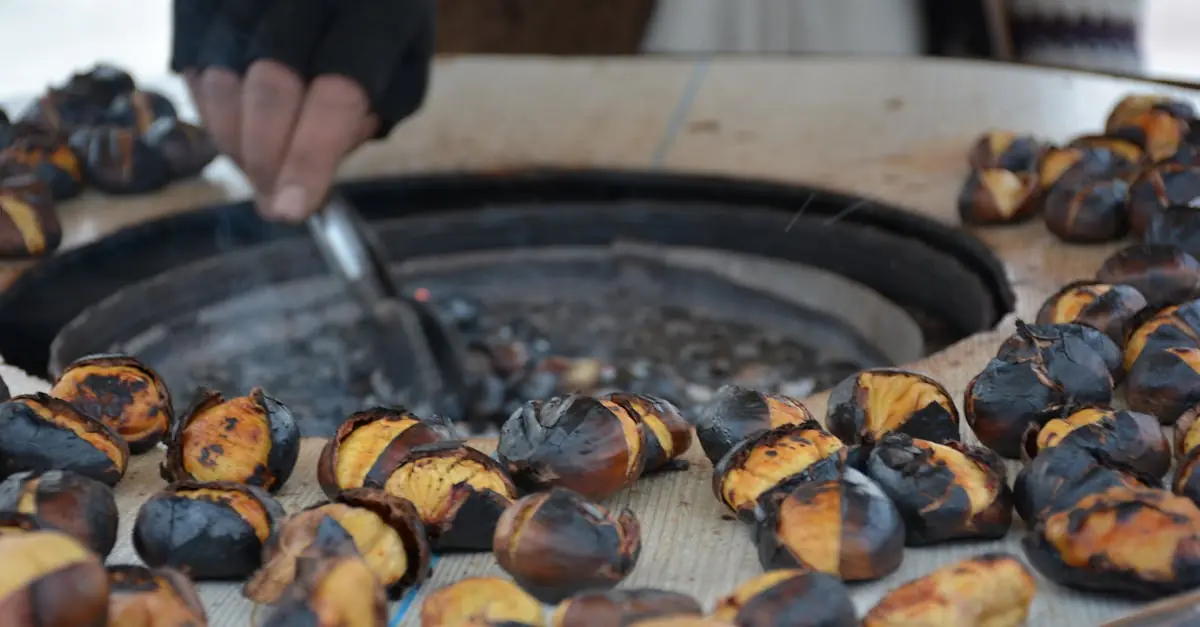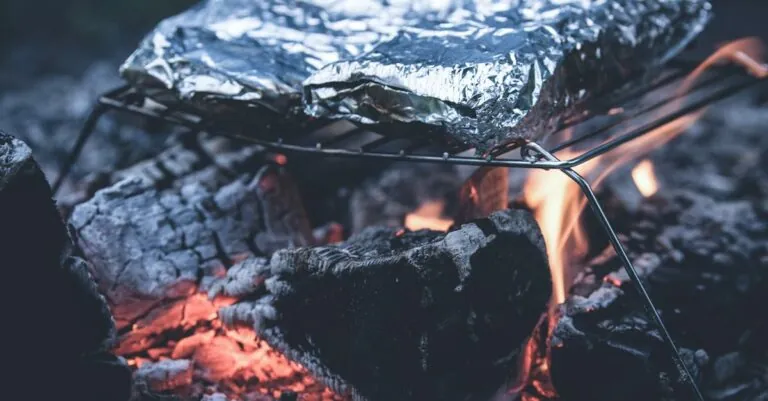As the chill of winter sets in and holiday lights twinkle, nothing quite captures the spirit of the season like the warm, inviting aroma of chestnuts roasting on an open fire. It’s a tradition that dates back centuries, turning simple nuts into a delightful treat that brings people together. Imagine the crackling fire, the laughter of friends, and the savory scent wafting through the air—it’s enough to make anyone feel nostalgic and hungry.
But let’s face it, roasting chestnuts isn’t just about the taste; it’s about the experience. It’s a culinary adventure that requires a bit of skill and a whole lot of heart. So grab your roasting pan and prepare to impress your guests with this timeless holiday classic. Whether you’re a seasoned pro or a curious newbie, there’s nothing quite like the joy of sharing perfectly roasted chestnuts on a chilly evening.
Table of Contents
ToggleOverview of Chestnut Roasting
Roasting chestnuts creates a delightful sensory experience during the winter months. This ancient practice traces back to various cultures and continues to capture the hearts of many. Chestnuts, when roasted, develop a rich, sweet flavor and a unique aroma that fills the air.
Preparation and technique play crucial roles in successful chestnut roasting. First, select high-quality, fresh chestnuts. They should feel heavy and firm with unblemished shells. Placing a slit in each chestnut prevents them from bursting open during roasting. This technique releases steam while enhancing the flavor.
Roasting methods vary, yet they all emphasize the connection to tradition. Some prefer open fires, which build an enchanting atmosphere, while others utilize ovens or stovetops for convenience. Regardless of the method, heating chestnuts produces a satisfying crackle as their shells open, unveiling tender, edible centers.
Timing impacts the outcome during the roasting process. Generally, roasting takes about 20-30 minutes, depending on the heat. Monitoring the chestnuts ensures even cooking and prevents excessive charring. A deliciously roasted chestnut showcases a golden-brown exterior, indicating it’s ready for enjoyment.
Serving chestnuts brings people together. Friends and family gather around a warm fire to savor the seasonal treat, creating a sense of community. Pair them with hot drinks, such as cider or cocoa, for a cozy winter experience. Enjoying roasted chestnuts showcases culinary skill while inviting everyone into the joy of the season.
History of Chestnut Roasting
Chestnut roasting has a rich history that spans centuries and cultures. This traditional practice brings people together, especially during the winter months.
Cultural Significance
Roasting chestnuts symbolizes warmth and community. In many cultures, the act of gathering around an open fire for chestnuts fosters connections among family and friends. Ancient Romans and European peasants revered chestnuts as a staple food source, particularly during the colder seasons. Festivals celebrating the harvest of chestnuts also reflect their cultural importance. For generations, festive gatherings have included chestnut roasting, establishing it as a cherished holiday ritual. The aroma of roasting chestnuts evokes nostalgia and a comforting atmosphere, enhancing the social experience of wintertime festivities.
Traditional Methods
Traditional chestnut roasting methods vary across regions. Open fires represent the oldest and most popular technique. Using a chestnut roasting pan or a simple metal grate allows for even cooking. Stovetop roasting also remains a common choice, often using a skillet with a lid. In modern kitchens, ovens provide a convenient alternative, ensuring a similar result. Slitting the chestnuts before roasting prevents bursting and enhances flavor. Specific wood types, such as oak or hickory, add unique smokiness to the chestnuts, creating distinctive taste profiles. Each method connects to a long-standing tradition, preserving the art of roasting chestnuts through generations.
Benefits of Chestnut Roasting
Roasting chestnuts offers numerous benefits that go beyond just the flavor. Appreciating these advantages enriches the overall experience.
Nutritional Advantages
Chestnuts provide a variety of essential nutrients. They contain vitamin C, which supports the immune system, and B vitamins that aid in energy production. Rich in fiber, chestnuts promote healthy digestion. Their low-fat content compared to other nuts emphasizes their appeal as a healthier snacking option. The presence of antioxidants helps combat oxidative stress, contributing to overall well-being. With their gluten-free nature, chestnuts suit various dietary needs, making them a versatile food choice.
Emotional and Social Aspects
The act of roasting chestnuts creates memorable experiences. Gathering around an open fire fosters a sense of community and shared joy, strengthening bonds among family and friends. Aromatic scents evoke nostalgia, often reminding people of festive gatherings. Celebrations centered around this tradition enhance the feelings of warmth and belonging. Engaging in the roasting process together encourages laughter and storytelling, creating cherished moments. These social interactions highlight its cultural significance during winter festivities, making each roasted chestnut a symbol of togetherness.
Modern Techniques for Roasting Chestnuts
Roasting chestnuts today incorporates both traditional and contemporary methods, catering to diverse preferences and settings.
Using Open Fires
Open fires create an authentic and nostalgic roasting environment. Roasting chestnuts this way enhances the flavor with a unique char and aroma. Placement of chestnuts in a sturdy, perforated pan prevents them from falling into the flames. Attentive roasting, typically requiring about 20 to 30 minutes, allows for even cooking while the fire crackles nearby. Watching the chestnuts pop as they roast adds to the sensory experience. Following the roasting, allowing them to rest briefly lets the steam soften the shells for easier peeling. The communal aspect of gathering around the fire fosters connections, making this method a cherished ritual.
Alternative Roasting Methods
Stovetop and oven techniques provide convenient alternatives for those without access to an open fire. On the stovetop, a cast iron skillet set over medium heat allows for easy monitoring, requiring about 15 to 20 minutes of roasting. Maintaining heat evenly ensures a consistent texture and flavor. For oven roasting, preheating to 425°F enables an efficient and hands-off approach. The chestnuts typically need 25 to 30 minutes, perfect for batch cooking. Using parchment paper or a shallow baking dish aids in bottom heat distribution. Each method preserves the natural flavors, making these techniques suitable for both novice and seasoned roasters alike.
Roasting chestnuts on an open fire captures the essence of winter joy and community. It’s a tradition that transcends generations bringing people together around warmth and flavor. The simple act of preparing these delightful treats fosters connections and creates lasting memories.
Whether choosing to embrace the time-honored method of an open fire or opting for modern conveniences, the experience remains rich and rewarding. The sensory delight of roasting chestnuts not only satisfies the palate but also enriches the spirit of the season.
As families and friends gather to enjoy this beloved holiday ritual, the aroma of roasted chestnuts serves as a reminder of the warmth and togetherness that define the winter months. Embracing this culinary adventure is sure to bring joy and nostalgia to any festive gathering.







